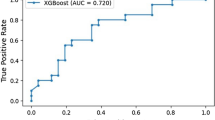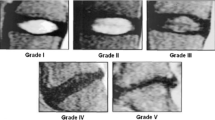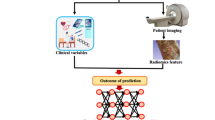Abstract
The prevalence of lumbar disc herniation (LDH), which makes patients’ daily activities more difficult and reduces their quality of life, has tended to increase recently. Many risk factors associated with LDH have been reported. In this study, LDH was predicted using machine learning techniques using measures of the lumbar paraspinal muscles, lumbar vessels cross-sectional area (CSA), and lumbar sagittal curve. Three hundred and forty-four individuals’ MR scans were prospectively enrolled (264 with LDH and 80 healthy). Predictive factors were the lumbar sagittal curve and the cross-sectional areas of the lumbar paraspinal muscles and vessels from sagittal and axial MR images. The measurements have been analyzed via ten different and most common machine learning algorithms by considering a comprehensive parameter tuning and cross-validation process. The variable importance results have been also presented. XGBoost algorithm among all algorithms has provided the best results in terms of different classification metrics including f-score (\(0.830\)), AUC (\(0.939\)), accuracy (\(0.922\)), and kappa (\(0.779\)). The findings of this study demonstrated that cross-sectional areas of the quadratus lumborum and abdominal aorta can be utilized as a reliable indicator of LDH. Consequently, the developed model and the variables found to be important may guide to healthcare professionals to make more accurate and effective decisions in terms of prediction the LDH.
Graphical abstract





Similar content being viewed by others
References
Hing E, Cherry DK, Woodwell DA (2006) National ambulatory medical care survey: 2004 summary. Adv Data 374:1–33
Amin RM, Andrade NS, Neuman BJ (2017) Lumbar disc herniation. Curr Rev Musculoskelet Med 10(4):507–516
Sun J, Shi J, Xu X, Yang Y, Wang Y, Kong Q, Yang H, Guo Y, Han D, Jiang J et al (2018) Anterior controllable antidisplacement and fusion surgery for the treatment of multilevel severe ossification of the posterior longitudinal ligament with myelopathy: preliminary clinical results of a novel technique. Eur Spine J 27(6):1469–1478
Mäki T, Oura P, Paananen M, Niinimäki J, Karppinen J, Junno J-A (2019) Longitudinal analysis of paraspinal muscle cross-sectional area during early adulthood–a 10-year follow-up mri study. Sci Rep 9(1):1–8
Niemeläinen R, Briand M-M, Battié MC (2011) Substantial asymmetry in paraspinal muscle cross-sectional area in healthy adults questions its value as a marker of low back pain and pathology. Spine 36(25):2152–2157
Sun D, Liu P, Cheng J, Ma Z, Liu J, Qin T (2017) Correlation between intervertebral disc degeneration, paraspinal muscle atrophy, and lumbar facet joints degeneration in patients with lumbar disc herniation. BMC Musculoskelet Disord 18(1):1–7
Ranger TA, Cicuttini FM, Jensen TS, Peiris WL, Hussain SM, Fairley J, Urquhart DM (2017) Are the size and composition of the paraspinal muscles associated with low back pain? a systematic review. Spine J 17(11):1729–1748
Ranger TA, Cicuttini FM, Jensen TS, Heritier S, Urquhart DM (2019) Paraspinal muscle cross-sectional area predicts low back disability but not pain intensity. Spine J 19(5):862–868
Bhargavan M, Sunshine JH, Schepps B (2002) Too few radiologists? Am J Roentgenol 178(5):1075–1082
Ghosh S, Chaudhary V (2014) Supervised methods for detection and segmen- tation of tissues in clinical lumbar mri. Comput Med Imaging Graph 38(7):639–649
Ren G, Liu L, Zhang P, Xie Z, Wang P, Zhang W, Wang H, Shen M, Deng L, Tao Y et al (2022) Machine learning predicts recurrent lumbar disc herniation following percutaneous endoscopic lumbar discectomy. Glob Spine J 1–7. https://doi.org/10.1177/21925682221097650
Ren G, Yu K, Xie Z, Liu L, Wang P, Zhang W, Wang Y, Wu X (2022) Differentiation of lumbar disc herniation and lumbar spinal stenosis using natural language processing–based machine learning based on positive symptoms. Neurosurg Focus 52(4):7
Endo K, Suzuki H, Tanaka H, Kang Y, Yamamoto K (2010) Sagittal spinal alignment in patients with lumbar disc herniation. Eur Spine J 19(3):435–438
Kauppila L (2009) Atherosclerosis and disc degeneration/low-back pain–a systematic review. Eur J Vasc Endovasc Surg 37(6):661–670
Fardon DF, Williams AL, Dohring EJ, Murtagh FR, Rothman SLG, Sze GK (2014) Lumbar disc nomenclature: version 2.0: Recommendations of the combined task forces of the north American spine society, the american society of spine radiology and the American society of neuroradiology. Spine J 14(11):2525–2545
Zacharia B, Fawas KM (2021) A comparative radiographic morphometric analysis to assess the normal radiological morphology of the adult hip in indian population. J Clin Orthop Trauma 15:117–124
Marras W, Jorgensen M, Granata K, Wiand B (2001) Female and male trunk geometry: size and prediction of the spine loading trunk muscles derived from mri. Clin Biomech 16(1):38–46
Meakin JR, Fulford J, Seymour R, Welsman JR, Knapp KM (2013) The relationship between sagittal curvature and extensor muscle volume in the lumbar spine. J Anat 222(6):608–614
Cox DR (1958) The regression analysis of binary sequences. J Roy Stat Soc: Ser B (Methodol) 20(2):215–232
Fix E, Hodges JL (1989) Discriminatory analysis. Nonparametric discrimination: consistency properties. Int Stat Rev/Revue Int Stat 57(3):238–247
Altman NS (1992) An introduction to kernel and nearest-neighbor nonparametric regression. Am Stat 46(3):175–185
Li B, Friedman J, Olshen R, Stone C (1984) Classification and regression trees (cart). Biometrics 40(3):358–361
Cortes C, Vapnik V (1995) Support-vector networks. Mach Learn 20(3):273–297
Drucker H, Burges CJ, Kaufman L, Smola A, Vapnik V (1996) Support vector regression machines. Adv Neural Inf Process Syst 9
Fisher R (1936) Linear discriminant analysis. Ann Eugenics 7:179
Hastie T, Tibshirani R, Friedman JH, Friedman JH (2009) The elements of statistical learning: data mining, Inference, and Prediction, vol 2. Springer
Haykin S (1994) Neural networks: a comprehensive foundation. Prentice Hall PTR
Quinlan R (2016). http://rulequest.com/. Accessed Aug 2022
Friedman JH (1991) Multivariate adaptive regression splines. Ann Stat 19(1):1–67
Breiman L (2001) Random forests. Mach Learn 45(1):5–32
Chen T, Guestrin C (2016) Xgboost: A scalable tree boosting system. In: Proceedings of the 22nd Acm Sigkdd International Conference on Knowledge Discovery and Data Mining, pp. 785–794
Michopoulou SK, Costaridou L, Panagiotopoulos E, Speller R, Panayiotakis G, Todd-Pokropek A (2009) Atlas-based segmentation of degenerated lumbar intervertebral discs from mr images of the spine. IEEE Trans Biomed Eng 56(9):2225–2231
Alomari R, Corso JJ, Chaudhary V, Dhillon G (2010) Computer-aided diagnosis of lumbar disc pathology from clinical lower spine MRI. Int J Comput Assist Radiol Surg 5(3):287–293
Oktay AB, Albayrak NB, Akgul YS (2014) Computer aided diagnosis of degenerative intervertebral disc diseases from lumbar MR images. Comput Med Imaging Graph 38(7):613–619
Ebrahimzadeh E, Fayaz F, Ahmadi F, Nikravan M (2018) A machine learning-based method in order to diagnose lumbar disc herniation disease by MR image processing. MedLife Open Access 1(1):1
Salehi E, Yousefi H, Rashidi H, Ghanaatti H (2019) Automatic diagnosis of disc herniation in two-dimensional MR images with combination of distinct features using machine learning methods. In: 2019 Scientific Meeting on Electrical-Electronics & Biomedical Engineering and Computer Science (EBBT), pp 1–6. https://doi.org/10.1109/EBBT.2019.87420521-6
Šušteršič T, Ranković V, Kovačević V, Milovanović V, Rasulić L, Filipović N (2021) Machine learning-based image processing in support of discus hernia diagnosis. In: 2021 IEEE 21st International Conference on Bioinformatics and Bioengineering (BIBE), pp. 1–5. https://doi.org/10.1109/BIBE52308.2021.9635305
Al-kubaisi A, Khamiss NN (2021) A transfer learning approach for lumbar spine disc state classification. Electronics 11(1):85
Harada GK, Siyaji ZK, Mallow GM, Hornung AL, Hassan F, Basques BA, Mohammed HA, Sayari AJ, Samartzis D, An HS (2021) Artificial intelligence predicts disk re-herniation following lumbar microdiscectomy: Development of the “rad” risk profile. Eur Spine J 30(8):2167–2175
Soin A, Hirschbeck M, Verdon M, Manchikanti L (2022) A pilot study implementing a machine learning algorithm to use artificial intelligence to diagnose spinal conditions. Pain Physician 25(2):171
Han M, Liu L, Hu M, Liu G, Li P (2022) Medical expert and machine learning analysis of lumbar disc herniation based on magnetic resonance imaging. Comput Methods Programs Biomed 213:106498
R Core Team (2022) R: A Language and environment for statistical computing. R Foundation for Statistical Computing, Vienna, Austria. R Foundation for Statistical Computing. https://www.R-project.org/. Accessed Aug 2022
RStudio Team (2019) RStudio: Integrated development environment for R. RStudio, Inc., Boston, MA. http://www.rstudio.com/. Accessed Aug 2022
Wickham H, Averick M, Bryan J, Chang W, McGowan LD, François R, Grolemund G, Hayes A, Henry L, Hester J, Kuhn M, Pedersen TL, Miller E, Bache SM, Müller K, Ooms J, Robinson D, Seidel DP, Spinu V, Takahashi K, Vaughan D, Wilke C, Woo K, Yutani H (2019) Welcome to the tidyverse. J Open Source Softw 4(43):1686. https://doi.org/10.21105/joss.01686
Kuhn M, Wickham H (2020) Tidymodels: a Collection of packages for modeling and machine learning using tidyverse principles. https://www.tidymodels.org. Accessed Aug 2022
Kuhn M, Johnson K et al (2013) Applied Predictive Modeling, vol 26. Springer
James G, Witten D, Hastie T, Tibshirani R (2013) An Introduction to Statistical Learning, vol 112. Springer
Kauppila LI (1997) Prevalence of stenotic changes in arteries supplying the lumbar spine a postmortem angiographic study on 140 subjects. Ann Rheum Dis 56(10):591–595
Shakeri A, Shakeri M, Behrooz MO (2016) Atherosclerosis and disc degeneration: a cross-sectional study. Am J Life Sci Res 4(4)
Tsai M-D, Jou S-B, Hsieh M-S (2002) A new method for lumbar herniated inter-vertebral disc diagnosis based on image analysis of transverse sections. Comput Med Imaging Graph 26(6):369–380
Acknowledgements
The authors would like to thank to their respective Universities for their support.
Author information
Authors and Affiliations
Contributions
Hikmet Kocaman: conceptualization, investigation, writing-original draft, writing-review editing, validation, supervision. Hasan Yıldırım: methodology, software, formal analysis, visualization, writing-original draft, writing-review editing. Aysenur Goksen: data curation, resources. Gokce Merve Arman: data curation.
Corresponding author
Ethics declarations
Ethics approval
The study was approved (No: 2022/11, Date: 03.06.2022) by Tarsus University Ethics Committee and performed following the Declaration of Helsinki. Before the study began, to use their MR images, the informed consent form was approved by each individual. Data collection was applied after the informed consent form was signed.
Conflict of interest
The authors declare no competing interests.
Additional information
Publisher's note
Springer Nature remains neutral with regard to jurisdictional claims in published maps and institutional affiliations.
Rights and permissions
Springer Nature or its licensor (e.g. a society or other partner) holds exclusive rights to this article under a publishing agreement with the author(s) or other rightsholder(s); author self-archiving of the accepted manuscript version of this article is solely governed by the terms of such publishing agreement and applicable law.
About this article
Cite this article
Kocaman, H., Yıldırım, H., Gökşen, A. et al. An investigation of machine learning algorithms for prediction of lumbar disc herniation. Med Biol Eng Comput 61, 2785–2795 (2023). https://doi.org/10.1007/s11517-023-02888-x
Received:
Accepted:
Published:
Issue Date:
DOI: https://doi.org/10.1007/s11517-023-02888-x




